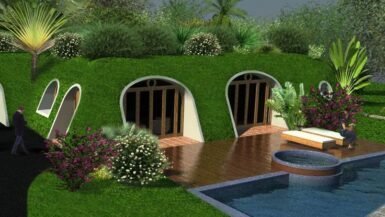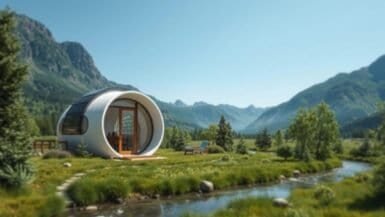As the tiny home movement continues to gain momentum, many enthusiasts are seeking ways to not only reduce their ecological footprint but also to enhance the sustainability of their living spaces. One such approach is the integration of edible landscaping around their tiny homes. This innovative method combines form and functionality, allowing homeowners to grow their own food while maintaining the aesthetics of their property. In this article, we will delve into the core aspects of creating an edible landscape around your tiny home, discussing the planning process, plant selection, and maintenance techniques to ensure a thriving, eco-friendly environment that contributes positively to your sustainable lifestyle.
Choosing Eco-Friendly and Edible Plants for Your Tiny Home Garden
Creating an edible landscape around your tiny home requires careful consideration of the types of plants that will thrive in your specific environment, while also providing you with fresh, organic produce. In this section, we will explore the essential factors to keep in mind when selecting suitable plants for your edible garden, ensuring successful growth and a bountiful harvest.
Local Climate and Soil Conditions
The first step in selecting the right plants for your edible landscape is understanding your local climate and soil conditions. Choose plants that are well-adapted to your region, taking into account factors like temperature, rainfall, and sunlight exposure. Native plants are particularly well-suited to local conditions, often requiring less maintenance and water than non-native species. Soil testing can provide valuable information about the nutrient content and pH levels, enabling you to make informed decisions when selecting plants and applying any necessary soil amendments.
Perennial vs. Annual Plants
Incorporating both perennial and annual plants into your edible landscape can provide a diverse array of food sources and visual interest throughout the year. Perennial plants, such as berry bushes, fruit trees, and rhubarb, will return year after year, offering a consistent food source with minimal replanting. Annual plants, like vegetables and herbs, have a single growing season and need to be replanted each year. Combining both types of plants can ensure a continuous supply of fresh produce and maintain a visually appealing landscape.
Optimizing Space with Companion Planting and Layering
When working with limited space in a tiny home garden, it’s essential to maximize every square inch. Companion planting refers to the practice of growing different plants in close proximity, where they can benefit from each other’s characteristics. For example, planting tomatoes and basil together can improve the flavor of both crops and help repel pests. Additionally, layering plants with varying heights and growth patterns can make the most of limited space, creating a lush, multi-dimensional landscape.
Choosing Plants for Aesthetic and Culinary Appeal
The visual appeal of your edible landscape is just as important as the food it provides. Select plants with diverse colors, textures, and shapes to create an attractive and dynamic garden. Consider using flowering plants like lavender and nasturtiums, which not only add beauty to your landscape but can also be used in culinary dishes. When selecting plants, prioritize those that offer multiple uses, such as edible flowers, leaves, and roots, to maximize the functionality of your garden.
By taking the time to thoughtfully choose eco-friendly and edible plants for your tiny home garden, you can create a thriving, sustainable landscape that provides fresh, organic produce while enhancing the beauty of your outdoor space.
Maximizing Space with Vertical Gardening Techniques
In the world of tiny homes, every square inch of space is valuable. As a result, it’s essential to find creative ways to make the most of your available gardening area. Vertical gardening techniques are an excellent solution for maximizing space while still cultivating a diverse and abundant edible landscape. In this section, we will explore several innovative methods for growing plants vertically, including trellises, living walls, and container gardens.
Embracing Trellises for Climbing and Vining Plants
Trellises are a versatile and practical method for growing plants vertically. They can be made from various materials, such as wood, metal, or bamboo, and come in many designs to suit your style preferences. Trellises are particularly useful for supporting climbing and vining plants, such as beans, peas, cucumbers, and squash. Not only do they help to maximize space, but they also improve air circulation around the plants, reducing the risk of diseases and pests.
Creating Living Walls for a Lush and Abundant Look
Living walls, also known as green walls or vertical gardens, are an increasingly popular method for incorporating plants into small spaces. Living walls feature plants growing directly on a vertical surface, such as a wall or fence, often using specialized containers or modular systems. Edible plants that thrive in living walls include herbs, leafy greens, and even some compact fruiting plants, like strawberries. In addition to saving space, living walls can provide insulation, reduce noise pollution, and create a visually stunning focal point in your landscape.
Utilizing Container Gardens for Flexible and Adaptable Planting
Container gardening is a versatile and adaptable option for growing plants vertically. By selecting containers of various shapes, sizes, and materials, you can create a unique and personalized edible landscape. Hanging baskets, window boxes, and tiered planters are all excellent choices for maximizing vertical space. Many edible plants can thrive in containers, such as tomatoes, peppers, herbs, and even small fruit trees. Container gardening also allows for greater flexibility, as plants can be relocated to optimize sun exposure or protect them from harsh weather conditions.
Optimizing Plant Growth with Vertical Garden Maintenance
To ensure the success of your vertical garden, it’s crucial to pay attention to proper plant care and maintenance. Regular watering, fertilizing, and pruning are essential for promoting healthy growth and preventing disease. Additionally, carefully selecting plants with compatible growing conditions, such as similar sunlight and moisture requirements, can increase the likelihood of a thriving and productive edible landscape.
By incorporating vertical gardening techniques into the design of your tiny home’s edible landscape, you can make the most of limited space while still enjoying the benefits of fresh, organic produce. With a little creativity and planning, you can create a visually appealing and bountiful garden that contributes positively to your sustainable lifestyle.
Incorporating Permaculture Principles for Self-Sustaining Landscapes
Permaculture, a combination of the words “permanent” and “agriculture,” offers a holistic approach to designing and maintaining sustainable and self-sufficient landscapes. By applying permaculture principles to your edible landscape, you can create a thriving ecosystem that works in harmony with nature, requiring minimal inputs and generating abundant yields. In this subsection, we will examine the key permaculture principles that can be integrated into your tiny home garden, resulting in a resilient and productive edible landscape.
Observing and Mimicking Natural Ecosystems
One of the fundamental principles of permaculture is observing and learning from nature. By studying how natural ecosystems function, you can apply these insights to your edible landscape, creating a self-sustaining system that requires minimal intervention. For example, by planting diverse species that perform different functions, such as nitrogen-fixing plants, ground cover, and pollinator attractors, you can create a balanced ecosystem that supports itself.
Utilizing Resources Wisely and Reducing Waste
Permaculture emphasizes the efficient use of available resources and the minimization of waste. In the context of your edible landscape, this could include capturing and storing rainwater, composting organic waste, and using renewable energy sources, such as solar or wind power. By thoughtfully managing your resources, you can create a closed-loop system that sustains itself with minimal external inputs.
Designing for Multiple Functions and Interconnectivity
Another core principle of permaculture is designing elements within your landscape to serve multiple functions and promote interconnectivity. For example, a fruit tree can provide food, shade, habitat for wildlife, and even serve as a trellis for climbing plants. By incorporating elements that serve multiple purposes, you can create a diverse and dynamic edible landscape that supports itself and your tiny home lifestyle.
Creating Resilience Through Diversity and Adaptability
A resilient landscape is one that can withstand and recover from disturbances, such as pests, diseases, and extreme weather events. Permaculture promotes the cultivation of a diverse array of plant species, which can help protect against crop failure and create a more stable and adaptable landscape. By selecting plants that thrive in various conditions and exhibit different growth patterns, you can create a resilient edible landscape that supports your tiny home’s self-sufficiency goals.
Applying permaculture principles to your edible landscape design can result in a thriving, self-sustaining ecosystem that complements your tiny home lifestyle. Through careful observation, resource management, and thoughtful design, you can create a balanced and resilient landscape that not only provides fresh, organic produce but also contributes to a sustainable and harmonious way of living.
Attracting Pollinators and Supporting Local Ecosystems
Creating an edible landscape around your tiny home not only provides you with fresh, organic produce but also offers an opportunity to support local ecosystems by attracting pollinators and beneficial insects. Pollinators play a crucial role in plant reproduction, helping to ensure the success of your edible garden while also promoting biodiversity within your local environment. In this subsection, we will explore the importance of pollinators in an edible landscape, discuss the types of plants that attract them, and offer tips for creating a pollinator-friendly garden.
The Crucial Role of Pollinators in Edible Landscapes
Pollinators, such as bees, butterflies, and hummingbirds, are essential for the success of many fruiting and flowering plants, transferring pollen from one flower to another and facilitating fertilization. Without the help of these essential creatures, your edible landscape may struggle to produce an abundant harvest. By attracting pollinators to your garden, you can increase the likelihood of successful pollination and enjoy a more bountiful yield of fruits, vegetables, and herbs.
Plant Selection for a Pollinator-Friendly Edible Landscape
Choosing the right plants for your edible landscape is crucial for attracting pollinators and supporting local ecosystems. Many flowering plants, including both annuals and perennials, provide nectar and pollen that attract these beneficial insects. Some examples of pollinator-friendly plants that can be incorporated into your edible landscape include:
– Flowering herbs, such as lavender, mint, and basil
– Native wildflowers, such as coneflowers, milkweed, and black-eyed Susans
– Fruit-bearing plants, like blueberries, raspberries, and strawberries
– Vegetables with attractive flowers, such as squash, cucumbers, and peas
When selecting plants, consider choosing a diverse range of species with varying bloom times, ensuring that your garden provides a continuous food source for pollinators throughout the growing season.
Creating a Habitat for Pollinators and Beneficial Insects
In addition to plant selection, providing a suitable habitat for pollinators and other beneficial insects is essential for supporting local ecosystems. Some tips for creating a welcoming environment for these vital creatures include:
– Offering a water source, such as a shallow dish or birdbath
– Leaving some areas of your garden undisturbed, allowing insects to nest and overwinter
– Avoiding the use of harmful pesticides and chemicals, which can harm pollinators and other beneficial insects
– Providing shelter, such as bee houses or brush piles, to encourage nesting and habitat diversity
By incorporating these strategies into your edible landscape design, you can create a thriving, pollinator-friendly environment that supports local ecosystems and contributes to the overall success of your tiny home garden.
In summary, attracting pollinators and supporting local ecosystems is an essential aspect of designing an edible landscape around your tiny home. By carefully selecting plants that provide a continuous food source for these beneficial creatures and creating a welcoming habitat, you can promote biodiversity, enhance the success of your garden, and contribute positively to your sustainable living goals.
Seasonal Planting and Harvesting Tips for Continuous Edible Landscapes
Creating a continuous edible landscape around your tiny home involves carefully planning your planting and harvesting schedule to ensure a steady supply of fresh, organic produce throughout the year. In this subsection, we will explore the importance of seasonal planting, offer tips for succession planting, and discuss the benefits of preserving your harvest for future use.
Understanding the Importance of Seasonal Planting
To create a continuous edible landscape, it’s crucial to understand the growing cycles of the plants you choose and their suitability for your local climate. Different plants thrive in various seasons, and by selecting species that perform well during specific times of the year, you can ensure a continuous harvest. For example, cool-season crops like lettuce, spinach, and peas can be planted in early spring and late fall, while warm-season crops such as tomatoes, peppers, and cucumbers are better suited for the summer months. Familiarize yourself with the unique growing requirements of each plant species and adjust your planting schedule accordingly.
Maximizing Your Harvest through Succession Planting
Succession planting is a valuable technique for maintaining a continuous edible landscape, allowing you to make the most of your available gardening space and extend your harvest season. This method involves planting a new crop immediately after harvesting the previous one, ensuring that your garden remains productive throughout the year. Some tips for successful succession planting include:
– Choosing fast-growing, early-maturing varieties to maximize your harvest window
– Rotating crops with different nutrient requirements to prevent soil depletion
– Staggering your planting schedule, so new plants are ready for harvest as previous ones are removed
– Utilizing cover crops to enrich the soil and prevent erosion during fallow periods
By incorporating succession planting into your edible landscape strategy, you can optimize your garden’s productivity and enjoy a continuous supply of fresh produce.
Preserving Your Harvest for Year-Round Enjoyment
In addition to careful planting and harvesting techniques, preserving your surplus produce can ensure a continuous supply of homegrown food throughout the year. There are various methods for preserving your harvest, including canning, freezing, dehydrating, and fermenting. Each method has its unique benefits and can be applied to different types of produce, allowing you to enjoy your garden’s bounty even during the off-season. By learning and applying these preservation techniques, you can create a well-stocked pantry filled with the fruits of your labor.
Through thoughtful planning, succession planting, and preservation techniques, you can create a continuous edible landscape that provides fresh, organic produce year-round. By understanding the unique growing requirements of each plant species and adapting your planting schedule to suit your local climate, you can successfully cultivate a diverse and abundant garden that enhances your tiny home’s sustainability and self-sufficiency.





Leave a reply